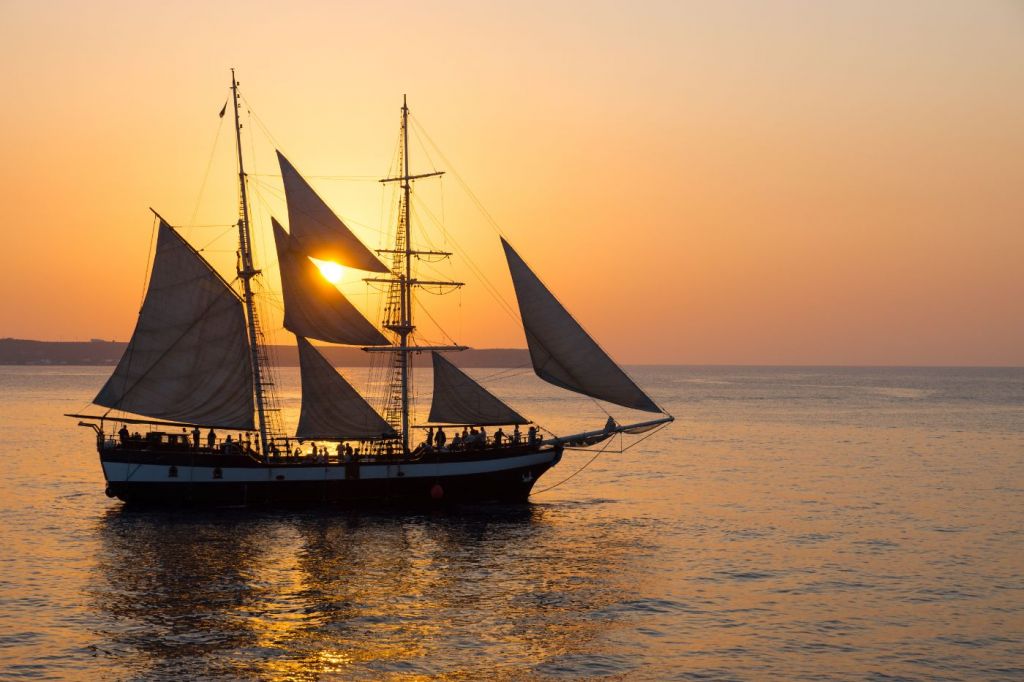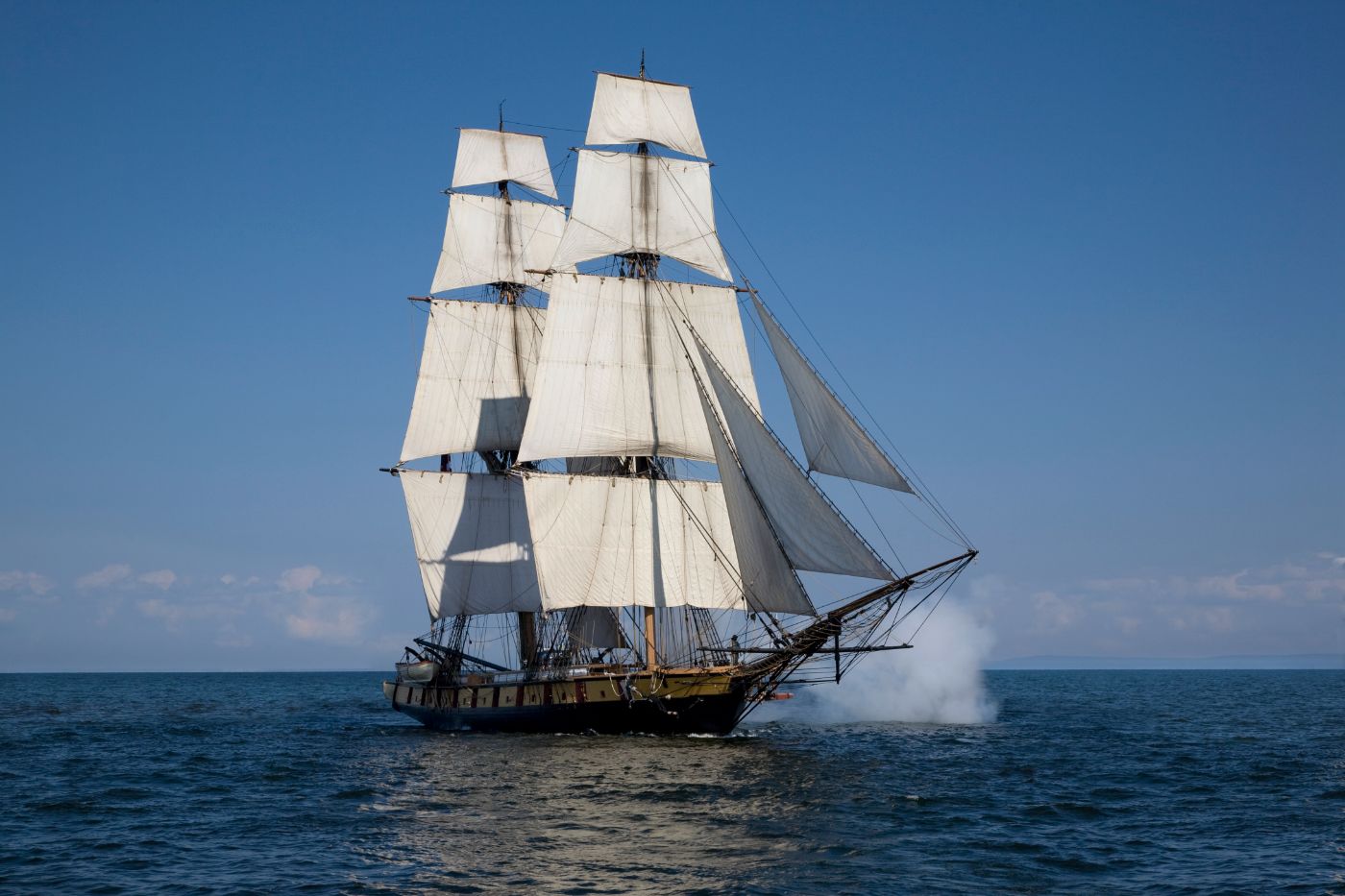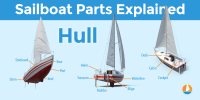What Is A Boat With 2 Masts Called? (5 Options)
The mast is the tall vertical pole that supports the sails, and some sailboat designs can have one or more masts. These types of sailboats are often used for cruising and racing, and they come in a variety of designs. In this article, we'll help you easily identify the different types of boats with two masts.
Popular two-masted sailboats include:
- Ketch
- Schooner
- Yawl
- Brig
- Brigantine
Ketches and yawls are more stable, while schooners, brigs, and brigantines are faster and more maneuverable. Rigging configurations vary, with some having square sails on both masts, and others having fore-and-aft sails on one or both masts.
One of the most important features of a two-masted sailboat is its sail plan. A ketch has a mainsail and a mizzen sail, while a schooner has multiple sails on each mast. Let's find out the sail plan for other types of two-masted sailboats and what other features they differ from each other.

Summary
- The mainmast and mizzenmast have different functions, with the former propelling the boat forward and the latter providing balance and stability.
- If you're looking for a 2-masted sailboat that is comfortable and easy to handle, a ketch or yawl might be a good choice.
- If you're looking for a 2-masted sailboat that is fast and maneuverable, a brigantine or schooner might be your best option.
- A brig has square sails on both masts, while a brigantine has a square sail on the foremast and a fore-and-aft sail on the mainmast.

On this page:
How to Recognize Each Sailboat
Below are the five most common types of two-masted sailboats and how you can quickly identify each:
| Sailboat Type | How to Recognize them |
|---|---|
| Ketch | One mast in the front and one in the back |
| Schooner | One mast in the front and one in the back, with the mainmast in the back |
| Yawl | One mast in the front and one in the back, with the mizzenmast in the back |
| Brig | Two mast masts, with the foremast being the taller of the two |
| Brigantine | One mast in the front and one in the back, with square sails on the front mast and fore-and-aft sails on the back mast |
In a two-masted sailboat, the mainmast usually carries the driving sail, which is responsible for propelling the boat forward. Meanwhile, the mizzenmast usually carries the balancing sail, which helps to balance the boat and keep it stable in different wind conditions.
Some sailboats are designed for speed, while others prioritize maneuverability and ease of handling. If you're looking for a sailboat that is comfortable and easy to handle, a ketch or yawl might be a good choice. These sailboats are generally more stable and easier to handle than other types of sailboats.
If you're looking for a sailboat that is fast and maneuverable, a brigantine or schooner might be a good choice. These sailboats are generally more difficult to handle than other types of sailboats, but they offer a thrilling sailing experience.
You can read more on two-masted sailboats in this article.
Ketch

How to recognize a ketch:
- a medium-sized sailboat (30 ft and up) with two masts
- a smaller mast in back
- a taller mast in front
- both masts have mainsails
- sails are fore-and-aft rigged
Sail design of a ketch
A ketch has two masts, with a taller mizzenmast located more towards the middle of the boat and behind the main mast. You can identify a ketch through this article.
The sail design of a ketch allows for more sail area options and versatility in different wind conditions.
The two masts allow for a variety of sail configurations that can be adjusted depending on the wind conditions, making the ketch more versatile and adaptable in different sailing conditions.
Performance and maneuverability of a ketch
A ketch can be efficient and fast, especially when sailing downwind, due to the mizzen mast helping to balance the boat and reduce load on the main sail. The smaller size of the mizzen sail can be useful in strong winds, providing a smaller area of sail to catch the wind.
Maneuvering a ketch can be challenging due to more lines and rigging, but skilled sailors can learn to handle it with practice.
Rigging configuration of a ketch
The rigging configuration of a ketch allows for more control over sail trim and balance, with the main sail attached to the main mast and the smaller mizzen sail attached to the mizzen mast. The sails can be adjusted independently of each other, allowing for versatility in different sailing conditions. The mizzen sail can be used to balance the boat and keep it on course in light winds, or reduce the load on the main sail in stronger winds.
The ketch rig also allows for finer control over the shape of the sails, with the mizzen sail used to adjust the angle of attack of the main sail and balance the boat when sailing close to the wind.
Schooner

How to recognize a schooner:
- a sailboat with mostly two masts
- a smaller mast in front
- a taller mast in the back
- sails are fore-and-aft rigged
- mainsails have gaff-rigging (spar on top of the sail)
Sail design of a schooner
A schooner is a two-masted sailboat with the mainmast taller than the foremast, and triangular-shaped sails. The sails on the forward mast are smaller than those on the aft mast. Here's how to recognize a schooner.
Schooners can be sailed with a smaller crew due to the ease of adjusting the sails, and are often used for racing due to their speed and agility.
Schooners can also be used for cruising, but are less maneuverable than yawls and ketches due to their size.
Performance and maneuverability of a schooner
A schooner can be fast, especially in light winds, and its rigging configuration allows it to sail close to the wind, making it a good choice for long-distance cruising.
Schooners can cover a lot of ground quickly due to their ability to sail at a greater angle to the wind than some other types of sailboats.
Maneuvering a schooner can be relatively easy with a skilled crew, as the sails can be adjusted quickly and easily, allowing for easier turning and maneuvering than some other types of sailboats.
Rigging configuration of a schooner
The rigging configuration of a schooner allows for a greater variety of sail configurations due to the two masts and different sizes of the sails on each mast. This allows for versatility in different wind conditions, with the sails set up in different ways to catch more wind or provide more power.
Schooners can sail faster and more efficiently in light winds due to the ability to adjust the sails on each mast. In stronger winds, the sails can be adjusted to reduce sail area and prevent the boat from being overpowered, through reefing or changing the sail configuration.
Yawl

How to recognize a yawl:
- a sailboat with two masts
- a main mast in front
- a much smaller mast in the back
- back mast doesn't carry a mainsail
- sails are fore-and-aft rigged
Sail design of a yawl
A yawl is a two-masted sailboat with a shorter mizzenmast located behind the mainmast, usually behind the rudder post. The smaller mizzen sail on the aft mast can be used to balance the boat and provide additional power in light winds, while the larger mainsail on the main mast can be used for more power in stronger winds.
The advantage of a yawl is that it allows for more flexibility in sail handling.
Performance and maneuverability of a yawl
A yawl can be slower than other types of sailboats due to the additional weight of the second mast and rigging, but can be more stable and easier to handle in rough seas.
Yawls are a popular choice for cruising and long-distance sailing due to their stability.
Yawls can be easily maneuvered even with a small but skilled crew, making them suitable for cruising.
Rigging configuration of a yawl
The rigging configuration of a yawl provides several advantages, including:
- Balance: The smaller mizzen sail on the aft mast helps to balance the boat and reduce weather helm (the tendency of the boat to turn into the wind). This makes the boat easier to steer and more comfortable to sail.
- Flexibility: The smaller mizzen sail can be used to help control the boat in a variety of wind conditions, while the larger mainsail on the main mast provides more power in stronger winds.
- Safety: The mizzen sail on the aft mast can be used as a backup sail in case the main sail on the main mast is damaged or needs to be taken down. This provides an added level of safety and security when sailing offshore or in rough conditions.
- Ease of handling: The smaller mizzen sail on the aft mast can be used to help turn the boat quickly and with more control, making it easier to navigate in tight spaces or tricky conditions.
| Sailboat Type | Location of Masts | Sail Plan | Rigging Configuration |
|---|---|---|---|
| Ketch | One in the front and one in the back | Main and mizzen sails | Fore-and-aft rigged mizzenmast, sometimes with a gaff-rigged sail |
| Schooner | One in the front and one in the back, with the mainmast in the back | Main and fore sails | Fore-and-aft rigged masts, sometimes with gaff-rigged sails |
| Yawl | One in the front and one in the back, with the mizzenmast in the back | Main and mizzen sails | Fore-and-aft rigged mizzenmast, sometimes with a gaff-rigged sail |
| Brig | Two masts, with the foremast being the taller of the two | Square sails on the foremast, fore-and-aft sails on the mainmast | Square-rigged foremast, fore-and-aft rigged mainmast |
| Brigantine | One in the front and one in the back, with square sails on the front mast and fore-and-aft sails on the back mast | Square sails on the foremast, fore-and-aft sails on the mainmast | Square-rigged foremast, fore-and-aft rigged mainmast |
Brig

How to recognize a brig:
- a sailboat with two masts
- a square-rigged foremast
- a mainmast that is either square-rigged or square-rigged and gaff-rigged
Sail design of a brig
A brig is a two-masted sailboat with square sails on both masts. The square sails are used to generate driving force when sailing downwind and are typically made of heavy canvas or durable materials. The sails are attached to the masts and yards using a series of ropes and lines known as the rigging.
The square sails on a brig are divided into smaller sections known as "panels," which can be adjusted individually to suit changing wind conditions.
Brig may also have one or more triangular-shaped fore-and-aft sails attached to the foremast, which can be adjusted using running rigging. Here's how to identify a brig.
Performance and maneuverability of a brig
The square-rigged sails of a brig allow it to sail closer to the wind than other types of sailing vessels, making it easier to maneuver in tight spaces and change direction quickly. This makes a brig ideal for naval warfare and piracy, where speed and maneuverability are essential for success.
The design of a brig allows for a smaller crew than other types of ships of similar size, which can make it easier to operate and maintain. Fewer crew members also means less weight and less space taken up by supplies and equipment, contributing to the ship's speed and maneuverability.
Rigging configuration of a brig
The rigging configuration of a brig typically includes square sails on both masts, which provide significant driving force when sailing downwind. However, this type of rig can be less effective when sailing upwind, as the sails are not as efficient at generating lift as a triangular sail.
One advantage of the brig's rigging configuration is that the square sails can be adjusted individually to suit changing wind conditions. The fore-and-aft sails can be used to fine-tune the vessel's speed and direction.
Brigantine

How to recognize a brigantine:
- a two-masted sailboat that is similar to a brig, but with a different rigging configuration
- a sailboat with a square-rigged foremast and a fore-and-aft rigged mainmast
- mainmast is typically taller than the foremast
- sails on the mainmast are fore-and-aft rigged, while the sails on the foremast are square-rigged
Sail design of a brigantine
A brigantine is a two-masted sailboat with square sails on the foremast and fore-and-aft sails on the mainmast. This configuration allows for a greater range of sail plan options. The square sails on the foremast can be used to drive the ship forward in strong winds, while the fore-and-aft sails on the mainmast can be used to maneuver the ship in more moderate winds.
Brigantines were used as cargo ships in the past and are still used for training and educational purposes.
Rigging configuration of a brigantine
The rigging configuration of a brigantine is complex, with multiple lines and cables used to control the sails and masts. The foremast typically has a topmast and a topgallant mast, while the mainmast may have a gaff and a boom to support the fore-and-aft sails. The rigging system includes shrouds, stays, and other lines that help stabilize the masts and sails and control their movement.
Performance and maneuverability of a brigantine
The combination of square and fore-and-aft sails allows for a greater range of sail plan options, which can help the ship maintain speed and maneuverability in different wind conditions.
However, the larger size and weight of the brigantine can make it more difficult to maneuver quickly or make sudden changes in direction, particularly in light winds.
For a better grasp of what each of these two-masted boats looks like, this article contains complete illustrations and pictures.
Famous Two-Masted Sailboats
Here are some of the most popular two-masted sailboats that you might know:
| Sailboat model | Rig type | Number of masts | Primary mast location | Mast description |
|---|---|---|---|---|
| Hinckley Bermuda 40 | Yawl | 2 | Forward | Mainmast is taller than the mizzenmast |
| Amel Super Maramu | Ketch | 2 | Forward | Mainmast is taller than the mizzenmast |
| Westsail 42 | Ketch | 2 | Forward | Mainmast is taller than the mizzenmast |
| Bluenose II | Schooner | 2 | Forward | Foremast is taller than the mainmast |
The sloop-rigged Hinckley Bermuda 40
The Hinckley Bermuda 40 is a classic sailboat that has been around since the 1960s. This boat is known for its beautiful lines, excellent handling, and comfortable interior.
The Bermuda 40 is a yawl-rigged sailboat, which means it has two masts, a mainmast, and a smaller mast called a mizzenmast. The mainmast is located forward, while the mizzenmast is aft. This arrangement allows for better balance and maneuverability, especially in heavy weather.
The ketch-rigged Amel Super Maramu
The Amel Super Maramu is a luxurious sailboat that is designed for long-distance cruising. This boat is known for its innovative features, such as an electric furling system, a hydraulic bow thruster, and a self-tacking jib.
The Super Maramu is a ketch-rigged sailboat, which means it has two masts, a taller mainmast, and a shorter mizzenmast. The mainmast is located forward, while the mizzenmast is aft. This configuration allows for better sail balance, especially when sailing downwind.
The ketch-rigged Westsail 42
The ketch-rigged Westsail 42 is a popular cruising sailboat that was designed by William Crealock in the 1970s. This boat is known for its sturdy construction and seaworthiness, making it a popular choice for long-distance cruising.
The ketch rig is known for being versatile and easy to handle, as it allows for a variety of sail combinations to be used depending on the wind conditions. It also allows for a versatile sail plan that can be easily adjusted to suit a wide range of wind conditions.
The schooner-rigged Bluenose II
The schooner-rigged Bluenose II is a replica of the original Bluenose, a famous Canadian racing schooner. The Bluenose II was built in 1963 and is used primarily as a tourist attraction and sail training vessel.
The schooner rig features two masts, with the forward mast being taller than the aft mast. This rig allows for a large sail area and a high degree of maneuverability, making it well-suited for racing and coastal cruising.
Did you find the answer to your specific question?
👍 1 👎 0




Leave a comment